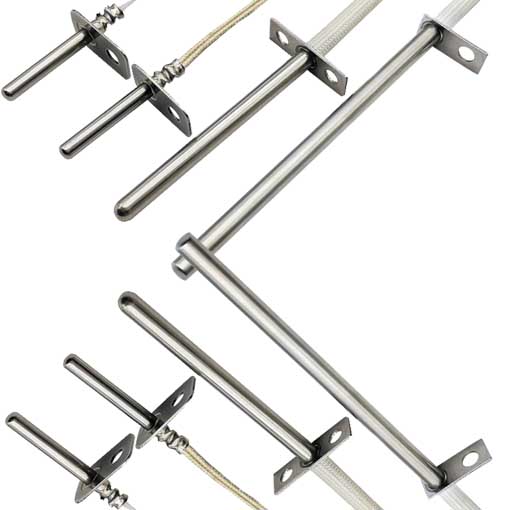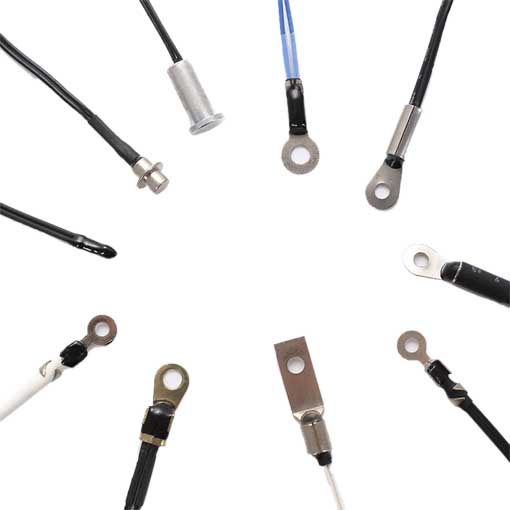Categorii de produse
- Întrerupător termic 20
- Suport cutie siguranțe 36
- Senzor de temperatura 67
- Comutator termic 64
- Siguranță auto 19
- Siguranțe înșurubate 7
- siguranță termica 32
- siguranțe de suprafață 12
- termistor 22
- Suport pentru siguranțe montat pe PCB 27
- Ham de cabluri 6
- Suporturi pentru siguranțe cu lame 17
- termostat 46
- Siguranta electrica 14
Etichete de produs
Postări recente
temperature sensing probe (PT100, termistor) Manufacturer
The temperature sensor known as the temperature sensing probe . In the home appliance control, it is generally used as a sensing element (PT100, termistor, Ds18b20) that senses the temperature of a specific part, and converts the temperature signal into an electrical signal to control the system to operate in a prescribed mode. The temperature sensors used in the refrigerator industry are mainly direct-heated negative temperature coefficient (NTC) termistori: Adică, in the working range, the thermistor whose resistance value decreases as the temperature of its resistor body increases.
Precautions for using the temperature probe:
In order to feel the accuracy of the temperature point, each temperature sensor must be fixedly installed in the corresponding position. În special, the temperature probe of each evaporator must be closely attached to the evaporator and in good contact with the evaporator. The sensing line and the temperature sensor must be sealed intact, without damage or cracking, to avoid parameter drift caused by moisture intrusion.
The first NTC sensor: Next to the second tube of the evaporator in the refrigerator;
The second NTC sensor: Inside the hinged lid on the door;
The third thermistor sensor: On the right side of the inner shelf of the upper shelf of the fruit and vegetable box in the refrigerator;
The fourth PT100 sensor: Beside the refrigeration tube behind the second drawer of the freezer;
5th Ds18b20 sensor: Inside the soft freezer evaporator.
The main function of the refrigerator NTC sensor:
1. Variable temperature zone Ds18b20 sensor: Temperature sensor for displaying the temperature and control of the changing greenhouse.
2. Refrigerator evaporator NTC sensor: Temperature sensor for controlling the temperature of the refrigerator compartment.
3. Defrost NTC sensor: The temperature sensor is generally disconnected at normal temperature, closed below -7 ° C, and the defrosting heater is energized to generate heat and defrost the evaporator.
4. The refrigerator operation sensor is used to observe whether the compressor is running.
5. The compressor protection sensor is used to protect the compressor.
6. There is a sensor for the refrigerator door. When the refrigerator door is opened, the light inside the refrigerator is turned on, the refrigerator door closed light is turned off, and so on.

thermistor temperature sensing probe

pt100 temperature sensing probe

temperature sensing probe
| model | Rated resistance value(R25) | valoarea B | Operating temperature | Dissipation factor(mW/℃) | Thermal time constant(S) | |
| Valoarea rezistenței (KΩ) | Tolerance (± %) | Nominal value (K) | ||||
| MF53-102-3950 | 1 | ±1% ±2% ±3% ±5% | 3950 | -40℃ ~ +300℃ | ≥2.0 Still air | ≤15 Still air |
| MF53-202-3435 | 2 | 3435 | ||||
| MF53-472-3950 | 4.7 | 3950 | ||||
| MF53-502-3470 | 5 | 3470 | ||||
| MF53-502-3950 | 5 | 3950 | ||||
| MF53-682-3950 | 6.8 | 3950 | ||||
| MF53-103-3435 | 10 | 3435 | ||||
| MF53-103-3470 | 10 | 3470 | ||||
| MF53-103-3600 | 10 | 3600 | ||||
| MF53-103-3950 | 10 | 3950 | ||||
| MF53-103-3977 | 10 | 3977 | ||||
| MF53-103-4100 | 10 | 4100 | ||||
| MF53-153-3950 | 15 | 3950 | ||||
| MF53-203-3950 | 20 | 3950 | ||||
| MF53-233-3950 | 23 | 3950 | ||||
| MF53-303-3950 | 30 | 3950 | ||||
| MF53-333-3950 | 33 | 3950 | ||||
| MF53-40.27-3950 | 40.27 | 3950 | ||||
| MF53-473-3950 | 47 | 3950 | ||||
| MF53-493.12-3950 | 49.12 | 3950 | ||||
| MF53-503-3950 | 50 | 3950 | ||||
| MF53-503-3990 | 50 | 3990 | ||||
| MF53-503-4050 | 50 | 4050 | ||||
| MF53-104-3950 | 100 | 3950 | ||||
| MF53-104-3990 | 100 | 3990 | ||||
| MF53-104-4200 | 100 | 4050 | ||||
| MF53-204-3950 | 200 | 3950 | ||||
| MF53-204-4260 | 200 | 4260 | ||||
Contactaţi-ne
Aștept e-mailul dvs, vă vom răspunde în termen 12 ore cu informații valoroase de care aveai nevoie.
 English
English العربية
العربية Български
Български 粤语
粤语 中文(简体)
中文(简体) 中文(漢字)
中文(漢字) Nederlands
Nederlands Suomi
Suomi Français
Français Deutsch
Deutsch Ελληνικά
Ελληνικά Magyar
Magyar Italiano
Italiano 日本語
日本語 한국어
한국어 Polski
Polski Português
Português Română
Română Русский
Русский Slovenščina
Slovenščina Español
Español Svenska
Svenska ภาษาไทย
ภาษาไทย Türkçe
Türkçe Tiếng Việt
Tiếng Việt




